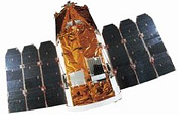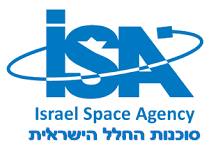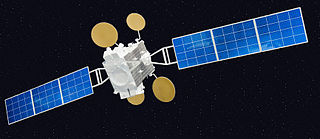| Names | Affordable Modular Optimized Satellite-8 |
|---|---|
| Mission type | Communications |
| Operator | Spacecom Satellite Communications |
| Mission duration | 16 years (planned) |
| Spacecraft properties | |
| Bus | SSL 1300 |
| Manufacturer | Maxar Technologies |
| Launch mass | 5,250 kg (11,570 lb) |
| Start of mission | |
| Launch date | 2021 (planned) - cancelled |
| Orbital parameters | |
| Reference system | Geocentric orbit (planned) |
| Regime | Geostationary orbit |
| Longitude | 4° West |
| Transponders | |
| Band | 65 transponders: 39 Ku-band 24 Ka-band 2 S-band |
| Coverage area | Israel, Europe, Africa, Asia, Middle East |
AMOS-8 was a planned Israeli communications satellite, one of the Spacecom AMOS series, to be built by Maxar Technologies, a US defense and aerospace company, to replace AMOS-3 and AMOS-7
AMOS stands for "Affordable Modular Optimized Satellite" and is also an allusion to the prophet Amos. [1]
AMOS-8 was to include flexible high power Ku-band, Ka-band, and S-band payloads with steerable antennas to enable customers to deliver various added value services. Spacecom had originally selected in March 2018 SSL to build the satellite, for US$112 million, but in September 2018 it was announced, that the satellite would not be built by SSL,. [2] Eventually the project was cancelled by Spacecom Satellite Communications.
The Government of Israel decided to order a satellite named "Dror-1", this satellite will be built by the state-owned Israel Aerospace Industries (IAI) to preserve the satellite building capability, although at a much higher price. [3]

SSL, formerly Space Systems/Loral, LLC (SS/L), of Palo Alto, California, is a wholly owned manufacturing subsidiary of Maxar Technologies.

Israel Aerospace Industries or IAI (תע"א) is Israel's major aerospace and aviation manufacturer, producing aerial and astronautic systems for both military and civilian usage. It has 15,000 employees as of 2018. IAI is state-owned by the government of Israel.

Earth Resources Observation Satellite (EROS) is a series of Israeli commercial Earth observation satellites, designed and manufactured by Israel Aircraft Industries (IAI), with optical payload supplied by El-Op. The satellites are owned and operated by ImageSat International N.V. (ISI), a company founded in 1997, as a Joint venture between IAI, El-Op and Core Software Technology (CST). EROS A was launched on December 5, 2000 and EROS B on April 25, 2006.

The Israel Space Agency is a governmental body, a part of Israel's Ministry of Science and Technology, that coordinates all Israeli space research programs with scientific and commercial goals.

AMOS is a series of Israeli communications satellites operated by Israel-based Spacecom. All AMOS satellites were developed by Israel Aerospace Industries (IAI) using the AMOS bus satellite bus, except for AMOS-5 which was developed by ISS Reshetnev using the Ekspress bus satellite bus, and AMOS-17 which was developed by Boeing on its BSS-702.
AsiaSat 2 was a Hong Kong communications satellite, which was owned, and was initially operated, by the Hong Kong based Asia Satellite Telecommunications Company. It was positioned in geostationary orbit at a longitude of 17° East of the Greenwich Meridian, on lease to Spacecom. It spent most of its operational life at 100.5° East, from where it was used to provide fixed satellite services, including broadcasting, audio and data transmission, to Asia and the Pacific Ocean.
Spacecom, or Space Communication, is an Israeli communications satellite operator in the Middle East, European Union and North America headquartered in the city of Ramat Gan, Israel. Spacecom operates two satellites at orbital position 4° West – AMOS-3 and AMOS-7, one satellite at orbital position 65° East – AMOS-4, and one satellite at orbital position 17° East – AMOS-5.
AMOS-1, then INTELSAT 24, is a commercial communications satellite which was operated by Spacecom as AMOS-1, for Affordable Modular Optimized Satellite and formed part of the AMOS series of satellites. It was the first Israeli civilian communications satellite, and was initially positioned at 4° West longitude in geostationary orbit. Then in September 2011, it was moved to 31° East.
AMOS-2 is an Israeli commercial second generation communication satellite, part of the AMOS series of satellites. The satellite was positioned at 4° West longitude in the geostationary orbit. Transmission and communication services given by this satellite include: direct distribution of television and radio translations to communication centers, distribution of internet services, data transmissions to communication networks. The new satellite, like its predecessor, will be positioned 36,000 kilometers above the Earth, and it will lie close to AMOS-1, so that the two can share a single space antenna.
AMOS-3, also known as AMOS-60, is an Israeli communications satellite operated by Spacecom Satellite Communications.
RISAT-2, or Radar Imaging Satellite-2 was an Indian radar imaging reconnaissance satellite that was part of India's RISAT programme. It was built by Indian Space Research Organisation (ISRO) and successfully launched aboard a PSLV-CA launch vehicle at 01:15:00 UTC on 20 April 2009 from the Second Launch Pad at the Satish Dhawan Space Centre.
The Earth Remote Observation System-A was part of the EROS family of Israeli commercial Earth observation satellites, designed and manufactured by Israel Aircraft Industries (IAI). This was the first satellite in the series. The satellite was owned and operated by ImageSat International, ImageSat International N.V. (ISI) headquartered at Limassol, Cyprus, and incorporated in the Netherlands Antilles, Cayman Islands.

AMOS-6 was an Israeli communications satellite, one of the Spacecom AMOS series, that was built by Israel Aerospace Industries (IAI), a defense and aerospace company.
AMOS-4 is an Israeli commercial communications satellite, operated by Spacecom Satellite Communications, Tel Aviv-based, part of the AMOS series of satellites.

Amos-5 was an Israeli commercial communications satellite, part of the AMOS series of satellites. It was developed and built for Spacecom by Information Satellite Systems Reshetnev, the largest Russian satellite producer, at a cost of US$157 million. The satellite was positioned at the 17° East longitude in the geostationary orbit. It was launched on 11 December 2011, 11:17:00 UTC from Baikonur Cosmodrome, Kazakhstan, atop a Proton-M / Briz-M launch vehicle. It provided coverage over the continent of Africa, as well as Europe and the Middle East.

AsiaSat 8 then AMOS-7 is a Hong Kong-turned-Israeli geostationary communications satellite which is operated by the Asia Satellite Telecommunications Company (Asiasat).
The AMOS, an acronym for Affordable Modular Optimized Satellite, is a family of light weight satellite bus for geostationary orbit communications satellite designed and manufactured by Israel Aerospace Industries (IAI) of Israel.

Beresheet was a demonstrator of a small robotic lunar lander and lunar probe operated by SpaceIL and Israel Aerospace Industries. Its aims included inspiring youth and promoting careers in science, technology, engineering, and mathematics (STEM), and landing its magnetometer, time capsule, and laser retroreflector on the Moon. The lander's gyroscopes failed on 11 April 2019 causing the main engine to shut off, which resulted in the lander crashing on the Moon. Its final resting position is 32.5956°N, 19.3496°E.
Nusantara Satu is an Indonesian communications satellite. It is a large high-throughput satellite (HTS) providing voice and data communications, and Internet access throughout the Indonesian archipelago and Southeast Asia.
AMOS-17 is an Israeli commercial communications satellite, part of the AMOS series of satellites.